S&P Global Offerings
Featured Topics
Featured Products
Events
S&P Global Offerings
Featured Topics
Featured Products
Events
By Nathan Stovall, Azadeh Nematzadeh , Lindsey White, Laura Skufca, Katie Darden, Corinne Bendersky, Tricia Sandiego, Carolann Faber, Cody White, Michael Wrobel, Molly Mintz, and Victoria Schumacher
Highlights
S&P Global, in partnership with AARP, examined Corporate America’s family leave policies to understand the relationship between family-friendly benefits and female representation in the workforce and senior management.
The research is based on the results of an S&P Global/AARP survey of 1,573 individuals—51% men and 49% women—who work for a firm with more than 1,000 employees. The survey was fielded between Aug. 20 and Sept. 8, 2020.
The research utilized gender and equality data from Equileap, which covers nearly 1,400 U.S. publicly-listed companies across 11 sectors, and data from the SAM Corporate Sustainability Assessment, an annual evaluation of more than 7,300 companies' sustainability practices across the globe issued by S&P Global, to measure correlations between certain policies and female representation in the workforce and senior management. The research also relies heavily on interviews of executives across corporate America about the benefits they have received and utilized, and their experiences in the workforce.
For employees worldwide, the coronavirus crisis is causing a clash of professional and personal responsibilities, and presents an urgent question for companies that want to retain their talent: How do you create policies that allow employees to balance career and family—both during a pandemic and beyond?

“MOM, CAN I HAVE A POPSICLE?”
One author of this report answered this question approximately 7,000 times while trying to research and write it while working from home with three small kids.
She’s not alone in her experience. For employees worldwide, the coronavirus crisis is causing a clash of professional and personal responsibilities, and presents an urgent question for companies that want to retain their talent: How do you create policies that allow employees to balance career and family—both during a pandemic and beyond?
For women, who still bear a greater responsibility of caring for children and aging relatives, the answer to this question could have profound implications for their participation and advancement in the workforce.
While U.S. corporate leave policies have expanded gradually in the past few decades, experts and executives say the coronavirus has forced a sharp and sudden acceleration in the pace of change in family-care benefits as companies and employees grapple in real-time with closures of daycares, schools, nursing homes, and offices.
Family leave in the U.S. lags the rest of the developed world. The U.S. is the only country within the Organization for Economic Cooperation and Development that doesn’t offer nationwide, statutory, paid family leave of any kind, whether maternity leave, paternity leave, or parental leave, according to a 2019 UNICEF report on family-friendly policies. In addition, the federal government doesn’t provide paid caregiving leave to its citizens nor mandates companies to do so.
While a number of states have enacted paid family leave laws, the U.S. private sector has largely taken the lead in such policies in the absence of federal mandates.
There are potential upsides to the pandemic for women in the workplace: COVID-19 has erased many of the barriers between personal and professional life. As employees work from home, children and family members have become regular fixtures in the background of online meetings, while bedrooms have become offices for many employees. Corporate America is facing a reckoning with the fact that employees have families and home responsibilities. This increased visibility could lead to better communication about the stress associated with family care, more expansive family-leave policies, and reduced stigma around taking such leave.
Importantly, it could also lead to greater flexibility around work schedules and work locations, in turn creating more options for employees who are juggling career and family responsibilities.
S&P Global, in partnership with AARP, found that companies offering flexible locations and hours tend to have lower turnover. As the pandemic changes the way America works, flexibility has become more important than ever, and for many employees will determine whether they can stay in the workforce or have to opt out to focus on caring for children, family members, or other adult loved ones.
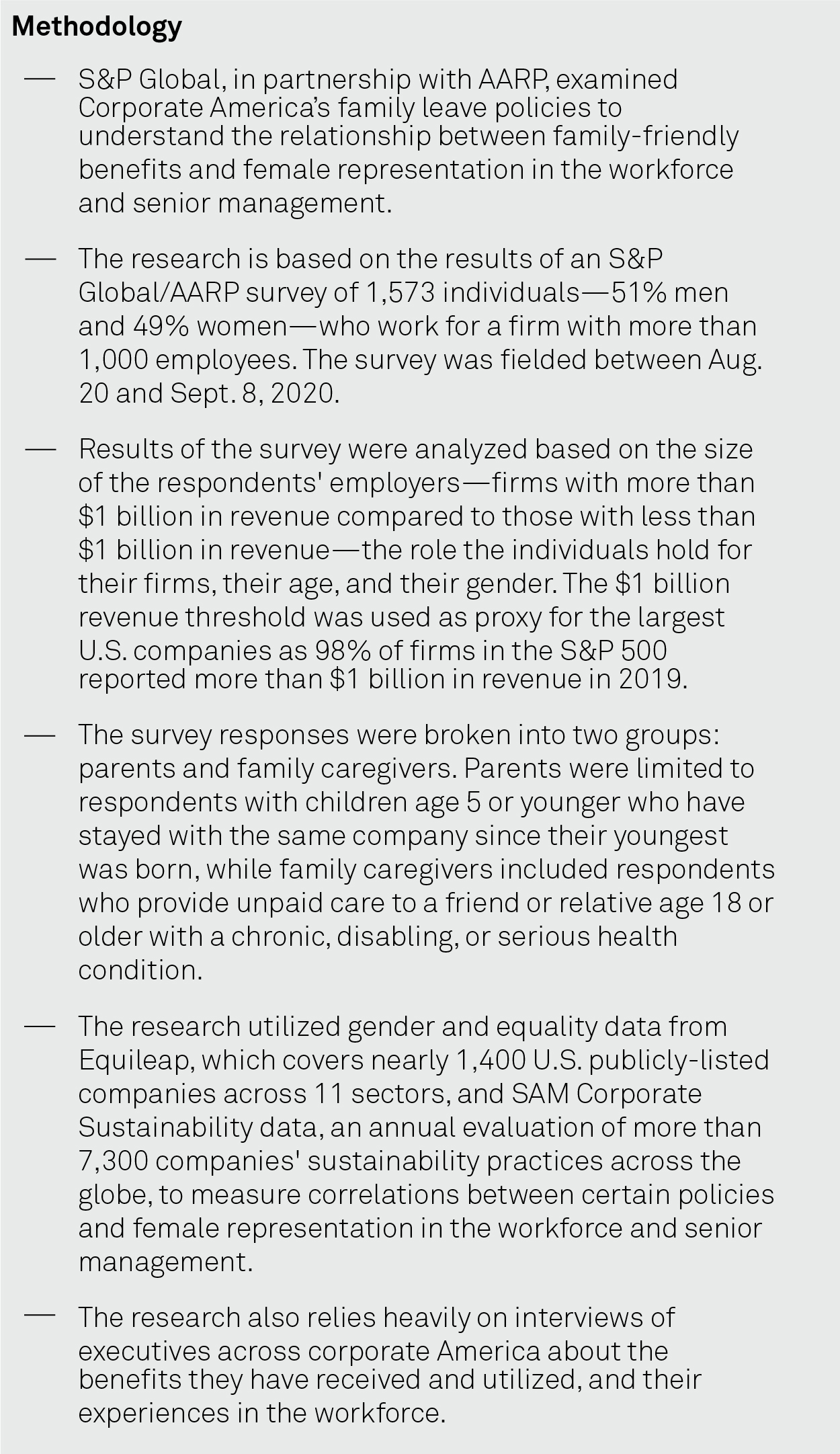
But COVID-19 could also have a dire effect on women in the workforce. A well known African proverb tells us that it takes a village to raise a child. During the pandemic, much of that village has shut down. Schools and daycares closed—and, even upon reopening, many have reduced capacity due to social distancing guidelines or have moved into virtual-learning environments that require adult supervision. In many cases, vital support networks of friends, neighbors, and babysitters were no longer available as the nation went into lockdown. In many households, grandparents who had been a key source of support could no longer provide childcare as their advanced ages made them more vulnerable to COVID-19. In a society where women still bear the bulk of family care responsibilities and a sizable gender pay gap persists, many female employees could be forced to abandon their careers to care for children or aging relatives and loved ones.
“As much as I wish it weren't the case, I still believe that women serve double duty,” said Pamela Sutton-Wallace, Senior Vice President and Regional Chief Operating Officer at NewYork-Presbyterian, one of the largest hospitals in the U.S.—a role she began in January 2020, just weeks before the pandemic turned New York City into a coronavirus hotspot. “In my generation, it's still the case that women are doing a disproportionate share of the housework and disproportionate share of the childcare-giving and parental support.”
Ms. Sutton-Wallace has two college-age daughters and a mother who lives with her. She is part of the "sandwich generation" of adults with a living parent age 65 or older who are also raising children or supporting them financially.
"Many of us are in that sandwich generation where we are still raising our children and now have to begin caring for our parents. And I'm on the early part of that journey,” she said in an interview with S&P Global. "While my mother is physically able to move around and is relatively physically healthy, we are starting to see her have early memory decline, and I think we're just hitting a point now where we're not comfortable with her being home alone.”
As the pandemic nears the seven-month mark in the U.S., some employees will hit a breaking point and start to drop out of the workforce to deal with family care responsibilities. In September alone, 865,000 women age 20 and older left the workforce, compared with 216,000 men within the same age bracket, according to a National Women’s Law Center analysis of Labor Department data.
Listen to a special episode of ESG Insider, an S&P Global podcast about environmental, social, and governance issues, on Spotify or Apple Podcasts to explore how corporate America is responding to COVID-19 with new policies for employees caring for children and elderly relatives.
More than half of parents and family caregivers responding to a survey conducted by S&P Global and AARP said they are spending more hours at home taking care of children or caring for adults since the pandemic began.
The survey was conducted during the summer, before most families were grappling with the reality of a return to school. In many parts of the country, the school year started with virtual classes.
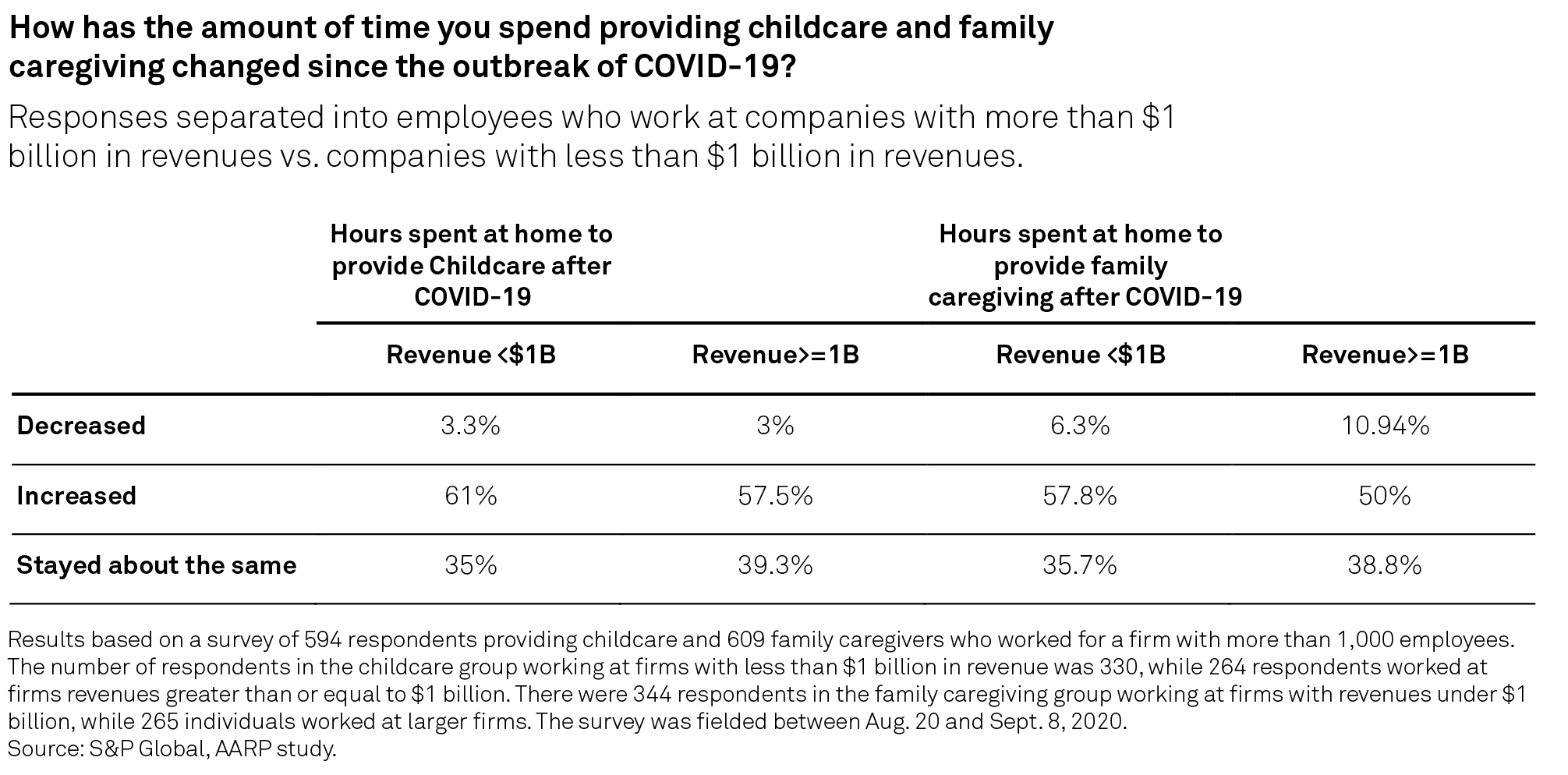
Parenting while working through the pandemic is akin to running a “marathon at a sprint pace,” according to Natasha Lamb, Managing Partner and Director of Equity Research & Shareholder Engagement at Arjuna Capital, a sustainable-investment firm she co-owns. Ms. Lamb is the mother of two elementary-school-age sons. In an interview with S&P Global, she described virtual schooling in the spring when the pandemic first hit as “a nightmare.”
“The schooling falls disproportionately on me as the mother, and that is a story that is shared, I think, in a lot of households,” Ms. Lamb said. "My husband and I are trying to think creatively about how we do that better and how we can better balance the scale, but it's tough.”

[Arjuna Capital Managing Partner and Director of Equity Research & Shareholder Engagement Natasha Lamb with her husband and sons. Source: Natasha Lamb]
More than 30% of parents in the S&P Global/AARP survey said they spent more than 20 hours a week on childcare before COVID-19, while 23% said they spent 11 to 20 hours a week taking care of children. The amount of time required for childcare duties since the pandemic began has increased for 58% of parents, according to the survey results.
How much time do you spend providing childcare and family caregiving after the outbreak of COVID-19?
Family caregivers make up close to 20% of the U.S. adult population and have seen their home commitments increase. There are approximately 48 million family caregivers providing care to an adult loved one, which could include caring for close friends, according to the National Alliance for Caregiving (NAC) and AARP 's "Caregiving in the U.S. 2020" study. As the U.S. population continues to age, and Baby Boomers reach older adulthood, the number of people needing care is only expected to rise.
Before the crisis disrupted typical routines and responsibilities, family commitments were considerable for many people. Close to 18% of respondents to the S&P Global/AARP survey said that before the pandemic, they spent more than 20 hours a week on family caregiving; 24% spent 11 to 20 hours a week; and 31% spent 6 to 10 hours a week. However, half of family caregivers said their responsibilities have increased since the pandemic started.

Since their commitments have grown, more than 30% of family caregivers in the survey said they were experiencing a strong increase in stress due to the pandemic's implications for their work-life responsibilities. Nearly 43% of respondents reported a moderate increase in stress.
Women have historically played a greater role in providing family care but men are contributing as well, with NAC/AARP finding 39% of caregivers are male. As caregiving needs have grown, 70% of men compared to 61% of women in the individual survey said they had some or a great deal of difficulty balancing work and their home life.
“Oftentimes before COVID hit, we always thought of working remotely or working from home as kind of this solution for work-life balance,” Ms. Sutton-Wallace told S&P Global. “In fact, I, by far, gave more hours working remotely than if I was physically present.”
The stress has taken a physical toll that she didn’t anticipate.
“Frankly, I was eager to get back to the office because it allowed me to walk, to be outside, to get fresh air, to see other people,” Ms. Sutton-Wallace said. “We're now just learning the mental-health toll that the pandemic is taking, continues to take, on our workforce.”

[Pamela Sutton-Wallace with her two daughters. Source: Pamela Sutton-Wallace]
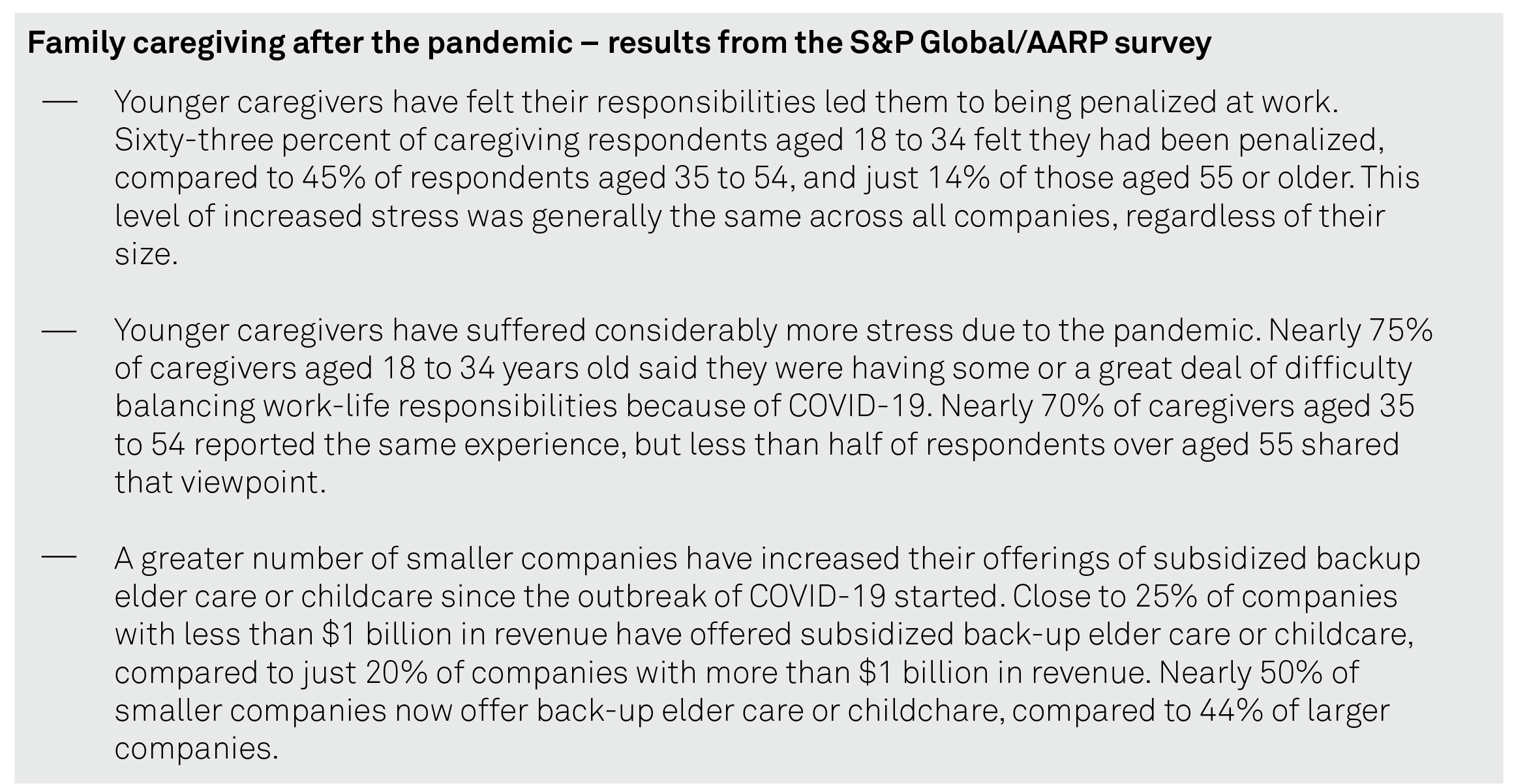
Some companies have responded to the stresses of the pandemic by providing flexible work arrangements, recognizing that a number of employees have found themselves balancing work with childcare or care for a loved one during the current crisis. Some firms have also provided employees with ad-hoc days off to allow them to recharge.
Close to 37% of respondents to the survey said their companies have added flexible work hours to their policies since the pandemic began, according to respondents in the S&P Global/AARP survey.
The percentage of companies adding flexible hours to their policies is nearly equal to the level of firms offering that benefit before the pandemic began. That suggests that nearly three-quarters of corporate America could now offer their employees some form of flexibility.
Benefits that companies offered before and after the outbreak of COVID-19 began
Responses separated into employees who work at companies with more than $1 billion in revenues vs. companies with less than $1 billion in revenue. Results include responses from parents and family caregivers who said one of the below benefits was made available before or after pandemic began.
Paid family leave has also become more common since the pandemic began but the benefits offered to family caregivers of adults has traditionally not kept pace with the benefits offered to new parents. Family caregiving does not lend itself to the same level of predictability as parental leave since it often waxes and wanes over time without warning and does not have a finite end date.
The results of the S&P/AARP survey supported that discrepancy. Nearly 22% of family caregivers responding to the survey who had unpaid family caregiving responsibilities in the past 12 months said their companies offered paid family leave designated for caregiving of adults. Comparatively, approximately 42% of parents responding to the survey said they were offered paid maternity/paternity leave at the time their child was born.
Larger firms have historically offered their employees a wider swath of benefits but some offerings have changed since the outbreak of COVID-19. Before COVID-19, smaller companies, firms with less than $1 billion in revenue, were less likely to offer employee support or resource groups, mental health or self-care resources or paid family leave. But a greater number of those smaller companies have introduced those policies since the outbreak of COVID-19, allowing them to narrow the gap with their larger counterparts.
Carol Sladek, partner in the consumer experience practice at Aon Hewitt and founder and leader of the company’s work-life consulting team, said the pandemic has thrust employers into a number of “sudden and chaotic experiments” regarding the benefits companies offer. Some employers are playing catch up and working to meet the immediate needs of their employees, but the coronavirus could spark a longer-term progressive movement toward more family-friendly benefits, she said.
The pandemic also seems to have elevated the importance of offering benefits for family caregivers. A number of employers have granted workers paid parental leave, but family caregiving historically hasn’t kept pace with the benefits offered to new parents. Ms. Sladek said companies began to “dabble” with family caregiving benefits before the coronavirus. COVID-19 has made family caregiving an even bigger issue because companies don’t want employees coming to work if they have an ill family member, she said.
"We've seen organizations with no choice,” Ms. Sladek said. “As a result, I am actually really optimistic about how much these trends have advanced in the last six months. And we've probably seen 10 to 15 years of growth that we would have seen at the traditional speed and curve."
Some employers are moving quickly to adapt their policies for working parents, too. Microsoft, for example, recently began offering a new pandemic school closure and childcare leave benefit that gives parents as many as 12 weeks of paid leave to care for their children at home. Rani Borkar, Corporate Vice President of Azure Hardware Systems and Infrastructure at the tech giant, said flexibility is the company’s new dogma.
“The only certainty now is we need to be flexible,” Ms. Borkar said.
Company policy plays a role in promoting that flexibility, but so does company culture. Ms. Borkar emphasized the importance of proactive communication between managers and employees, with a recognition that “one size doesn’t fit all.”
“Everybody has unique challenges. And the more we understand, the more we can operate as a community and really help and support each other,” she said. “It's all about finding solutions, being flexible. And through my three decades of journey in high tech, I have found that there is always a solution.”

[Rani Borkar, Microsoft Corporate Vice President of Azure Hardware Systems and Infrastructure. Source: Rani Borkar]
Flexibility can be an effective tool to recruit and retain women. S&P Global and AARP analyzed data from Equileap, a provider of gender-equality data and insights, and found that 319 companies of the 1,389 in its sample offer flexible hours and ensure equal recruitment policies. Companies with equal recruitment strategies commit to ensure non-discrimination against any type of demographic group and equal opportunities to ensure gender parity. We found that companies with equal recruitment policies and flexible hours tend to recruit more women, showing a Pearson correlation of 0.22.
We also found that companies that offer flexible hours tend to see lower voluntary and total turnover rates. The correlation was statistically significant for flexible hours and total turnover.

Flexible work arrangements also appear to help with retention of employees. Turnover is lower when companies have flexible hours and location options, according to our analysis of data from Equileap and S&P Global's SAM Corporate Sustainability Assessment(opens in a new tab) Data, an annual evaluation of more than 7,300 companies' sustainability practices across the globe.
The correlation between flexible locations and lower turnover is statistically significant. Our analysis also shows that greater female representation on the board and in executive positions tends to be associated with flexible hours offered to employees, although there was no clear trend on flexible locations.
In some cases, flexible managers can make the difference between a new mother staying in the workforce and pursuing her career, or dropping out. This was true well before the pandemic.
Ms. Sutton-Wallace, the healthcare executive, said she was put on hospitalized bedrest midway through her pregnancy with her first child, who is now 21. At the time, the only benefit she had to rely on was the Family Medical Leave Act, which guarantees 12 weeks of unpaid leave through the federal government. When her daughter was born prematurely, she had already exhausted seven of those 12 weeks.
“I only had five weeks home with her,” Ms. Sutton-Wallace recalled. “It was crushing.”
Her manager made all the difference. "I had a boss who was just incredibly understanding and he let me work from home as much as I could. He was flexible by allowing me to go to the hospital to visit [my daughter] as much as I needed to. He allowed me to make up time on weekends and off hours. And then he was just incredibly supportive.”
This kind of flexibility and support, coupled with better leave policies, can help employers find and keep talent. Ms. Sutton-Wallace has also seen family care leave policies expand and change in the past two decades.
“I think organizations have done that because they want to retain and recruit talent as more and more women make up the majority of the professional workforce. And I think more men are now insisting that they also be allowed to be involved early on in their children's lives and share in that responsibility,” she said.
Some sectors offer more robust family leave than others. Equileap collected data based on company disclosures and questionnaires on 1,389 U.S. publicly listed companies across 11 sectors with a market capitalization of $2 billion or more. Overall, Equileap found that only 10% of companies surveyed offer 14 weeks or more of at least two-thirds paid primary parental leave, which is the minimum number of weeks of maternity leave suggested under the Maternity Protection Convention of the International Labor Organization. Primary carers often receive that designation if they are the birth parent or if their spouse or partner isn’t at home to take on childcare duties at the same time as the employee.
Just 19% of companies offer a minimum of two weeks of paid secondary parental leave—defined as the person who isn’t leading the childcare duties— to U.S. employees. Of the 792 companies that disclose the number of weeks of leave they offer, 74% offer no paid primary leave, and 77% offered no paid secondary leave. These figures could well change as the pandemic casts a spotlight on company family care leave policies.
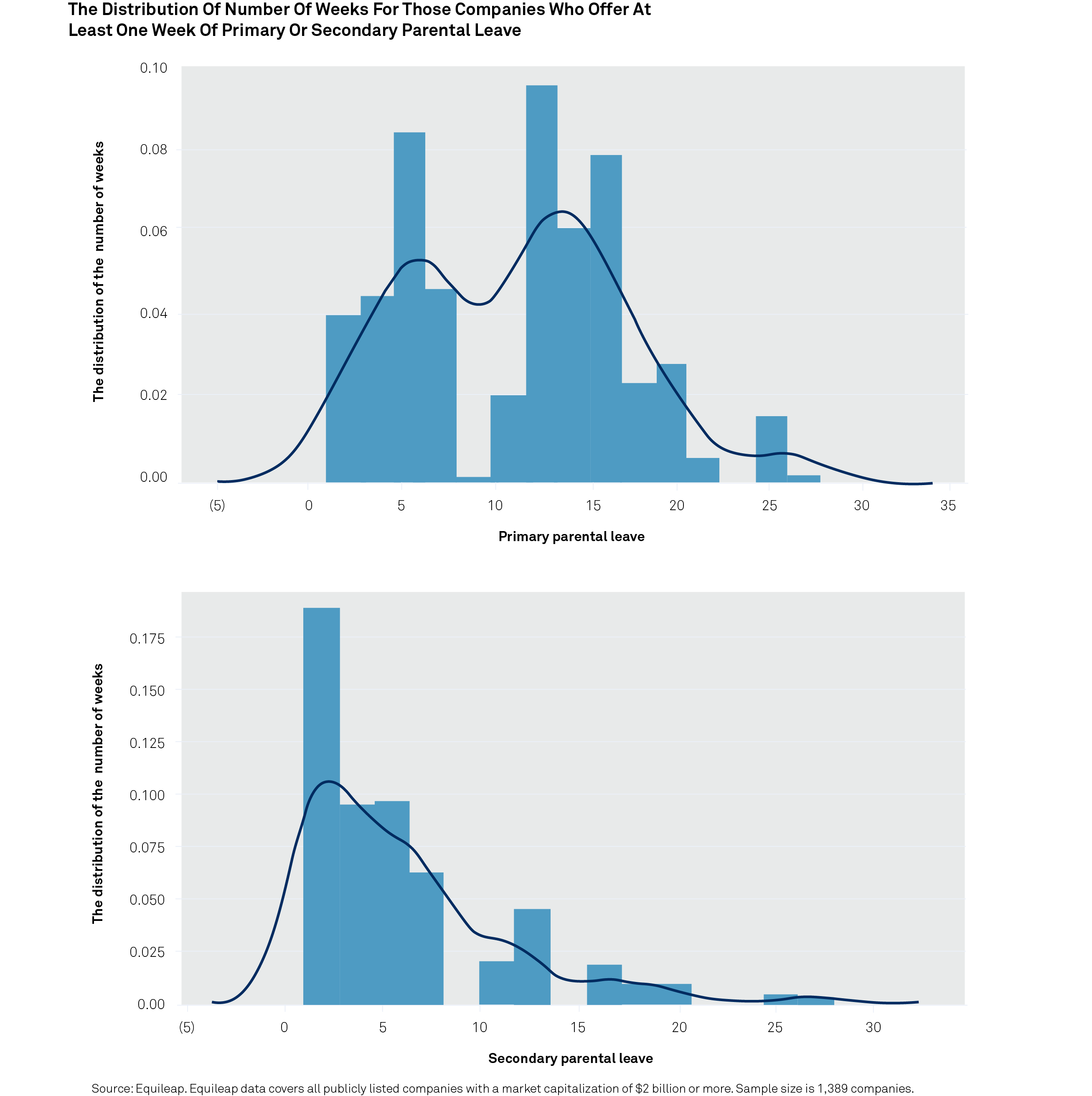
More than 30% of companies in the Communications-Services sector (which includes Telecom, Media, Movies and Entertainment, and Cable and Satellite Providers) offered a minimum of 14 weeks of paid primary parental leave, followed by just over 15% in the Information Technology sector, according to Equileap. Less than 10% of companies in the Energy, Consumer Staples, Industrials, Materials, Utilities, and Real Estate sectors offered a minimum of 14 weeks of paid primary parental leave.
The same two sectors led the way in secondary parental leave: 26% of Information Technology companies offer at least two weeks of secondary care leave, while nearly 25% of Communications-Services firms offered the two-week minimum.
The S&P Global and AARP analysis of Equileap’s data found that companies offering two weeks of secondary leave are more prevalent than entities offering 14 weeks of primary leave. There appeared to be a strong correlation between the number of weeks of parental leave offered primary caregivers and female representation at the board level. The correlation was quite high in Consumer Staples and Financials, at 0.39 and 0.27, respectively.
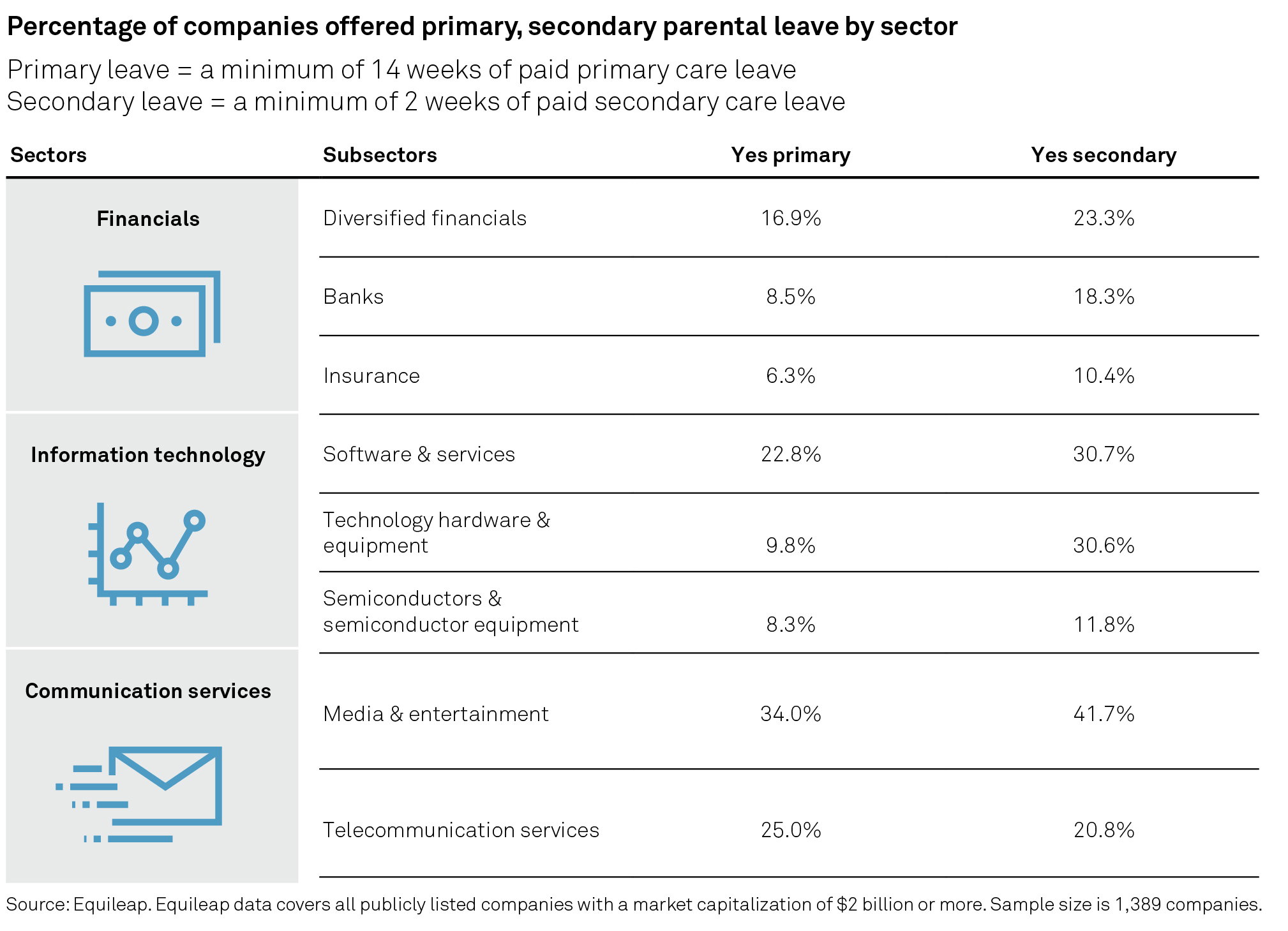
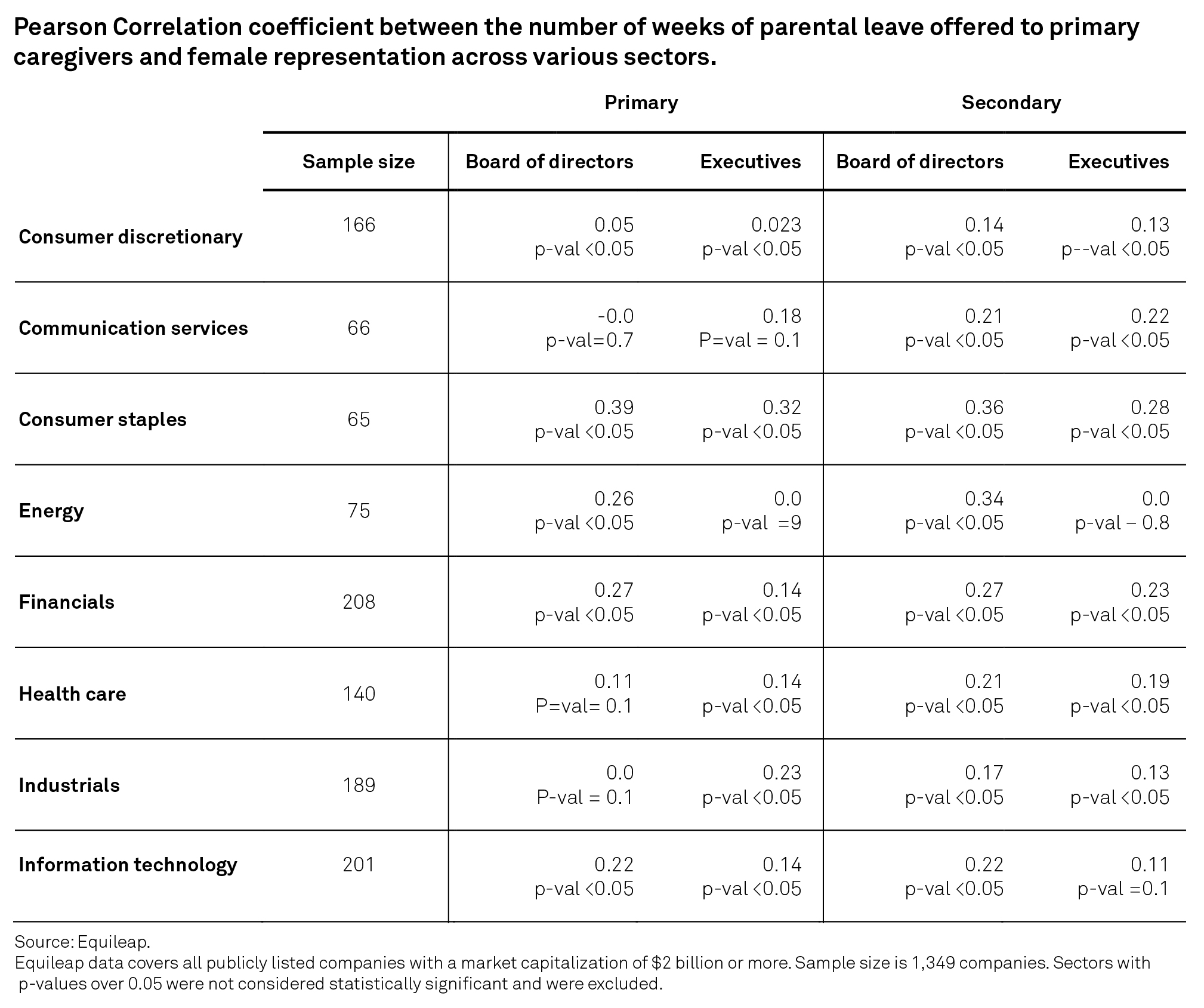
Our analysis of the Equileap data found that companies offer an average of just under three weeks of paid leave for primary parental carers and 1.25 weeks for secondary parental carers. The most generous leave benefits involved a maximum of 28 weeks offered to both primary and secondary carers.
More than 40% of respondents in the S&P Global/AARP survey said they took less than three weeks off following the birth or adoption of a child. Just 10% of respondents took more than 12 weeks off.
Employees at the largest companies in the U.S. took the most time off. Nearly 30% of respondents in the S&P Global/AARP survey at firms with more than $10 billion in revenue took seven weeks or more after the birth or adoption of their child.
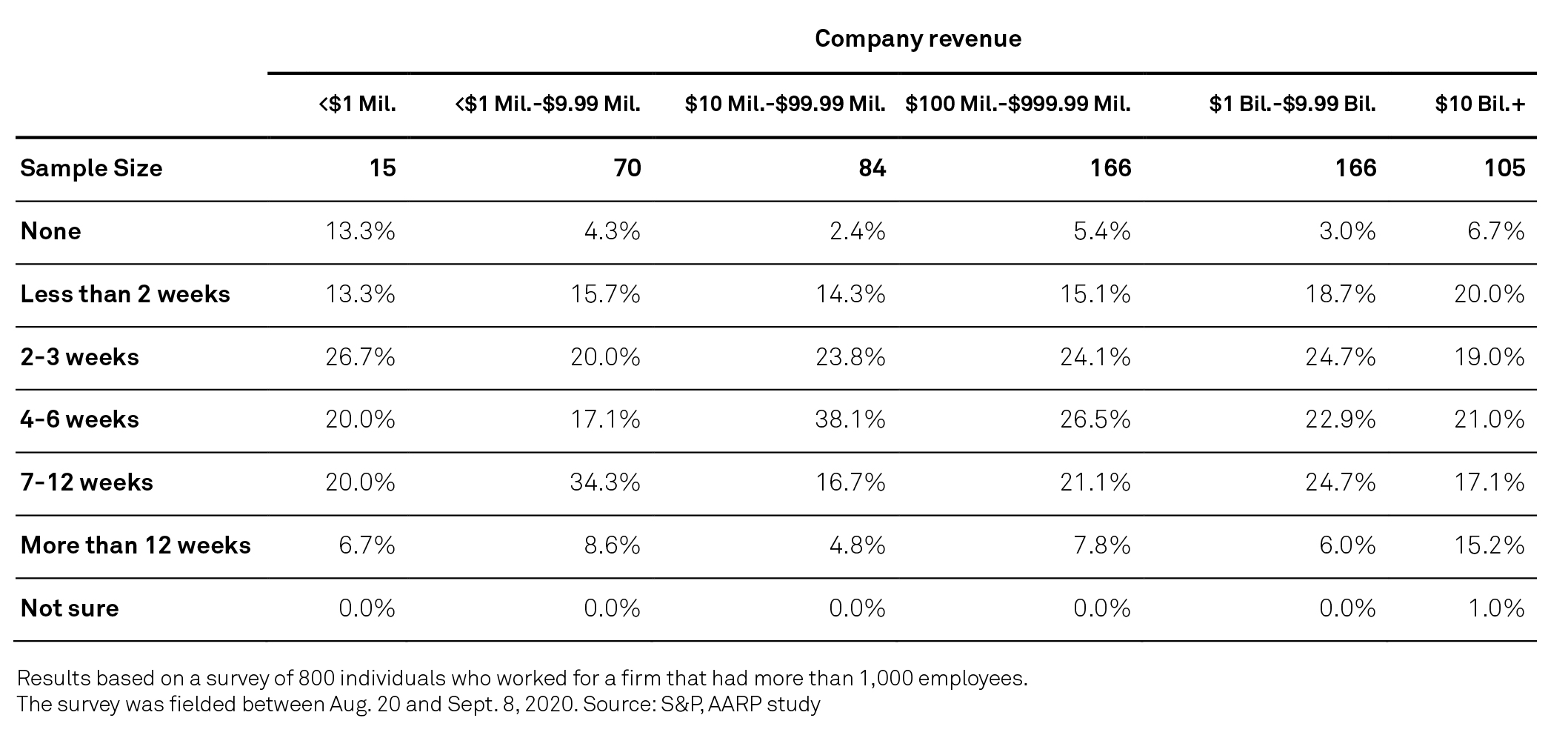
The results of the individual survey also show that larger companies offered a wider variety of benefits to their employees. Nearly 60% of respondents at companies with more than $1 billion in revenue said their companies offered paid maternity or paternity leave, compared to 42% at companies with less than $1 billion in revenue. Forty-three percent of respondents at companies with more than $1 billion in revenue said their companies offered unpaid leave for parents or caregivers—five percentage points higher than the level reported by individuals at firms with less than $1 billion in revenue.
Larger companies were more likely to offer flexible work schedules as well. Forty-three percent of parent respondents at companies with more than $1 billion in revenue said flexible work schedules were made available to them, compared to 38% of respondents at companies with less than $1 billion in revenue.
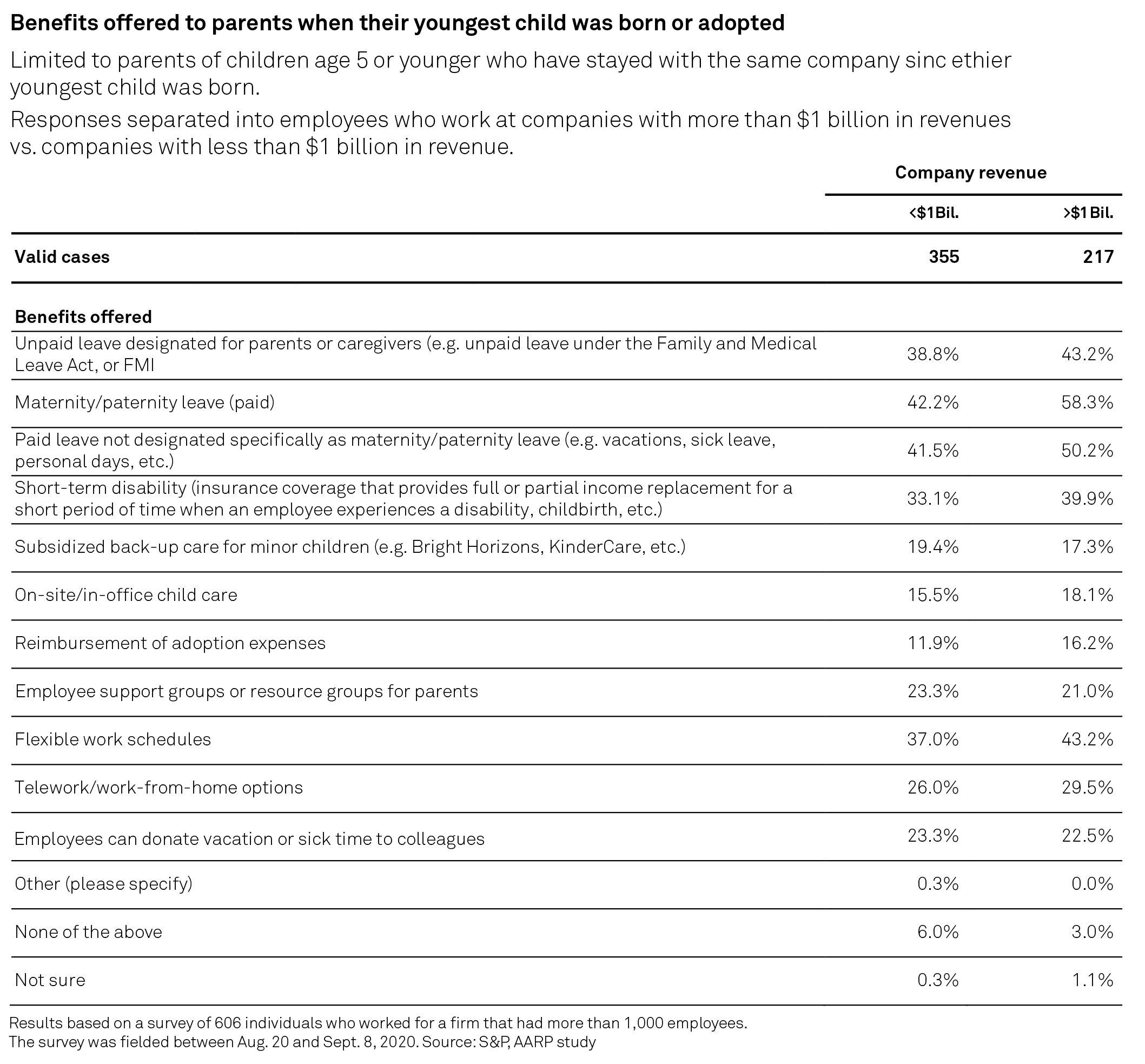
The offering of flexible work schedules varied notably from one sector to another and even differed from survey respondents who identified themselves as parents of younger children versus those with family caregiving responsibilities in the last 12 months.
Nearly 42% of family caregivers in the survey who worked in the consumer sector said their firms offered flexible work schedules, followed by 37% in the industrials sector and nearly 38% in the financials sector. Paid family care leave was most common among respondents working in the real estate sector, where 44% of respondents said their firms offered the benefit, followed by 35% in the industrials sector.
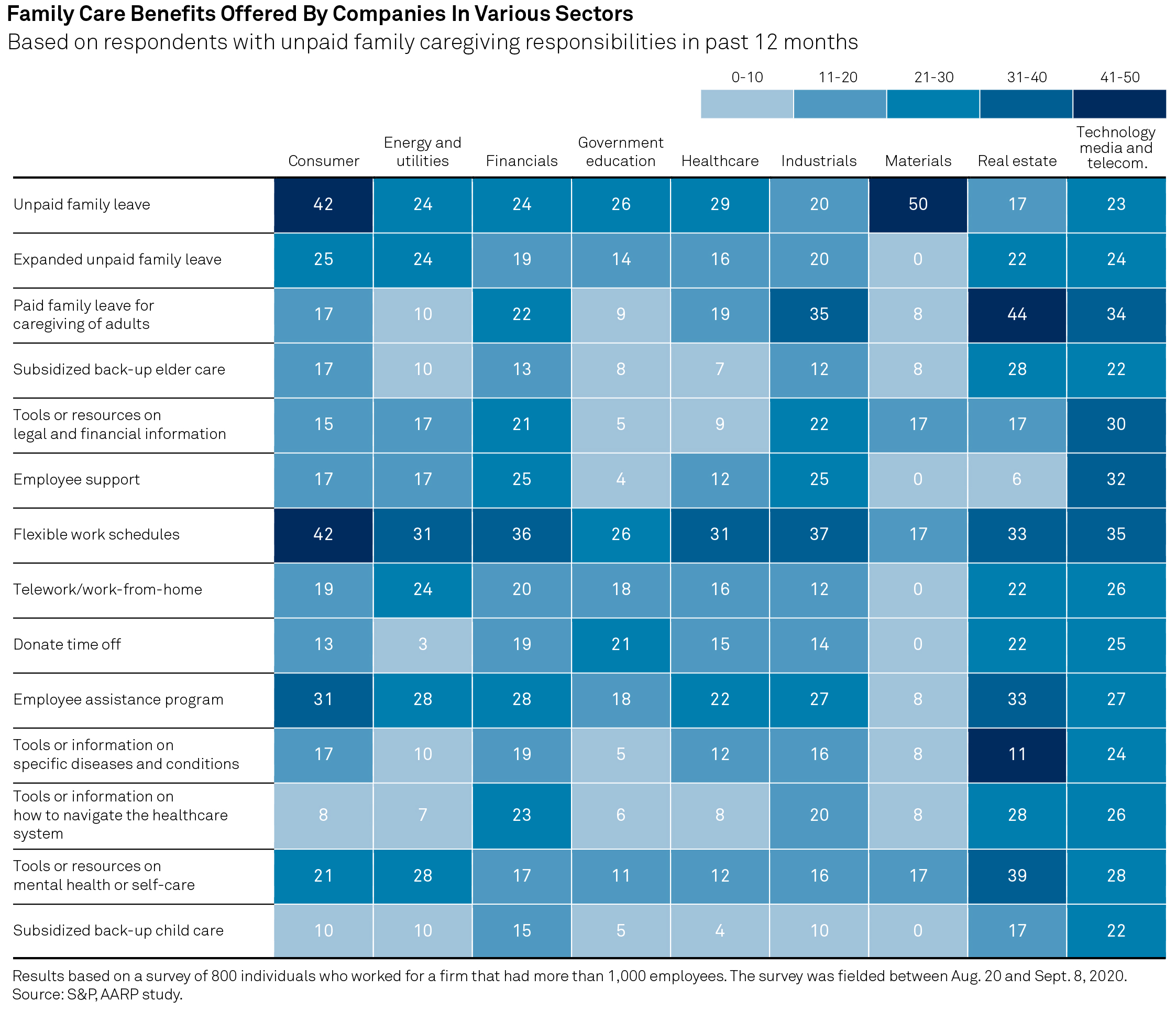
Meanwhile, 50% of parents in the survey who worked in the industrials sector said their firms offered flexible work schedules, followed by 49% in the technology, media and telecommunications sector and nearly 41% in the financials sector. The financials sector also led the way with paid maternity/paternity leave, with nearly 64% of parents working in the sector saying in the survey their firm made that benefit available.
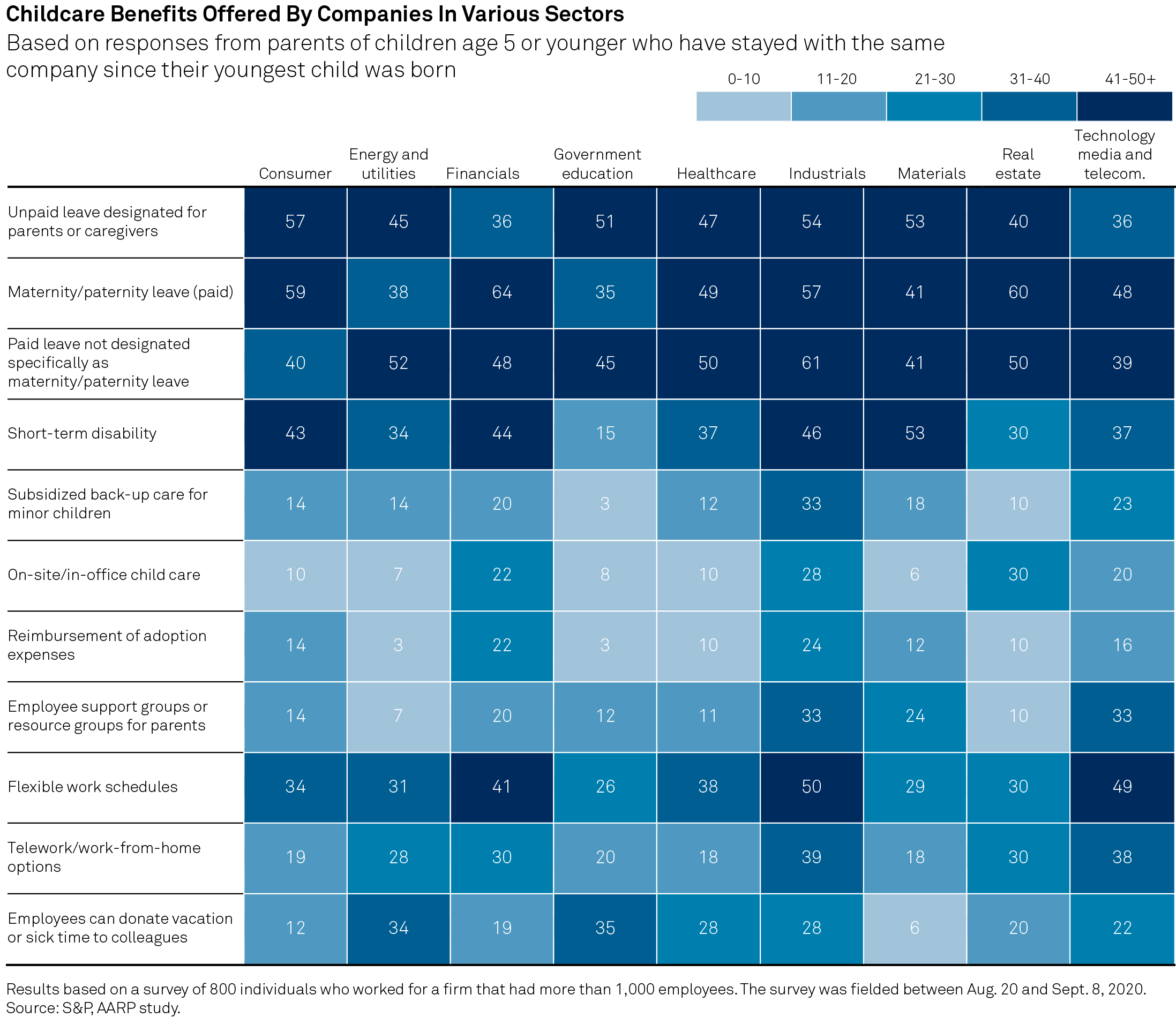
Across sectors, larger companies tend to offer more benefits, but smaller firms often have more room to maneuver. Lola, a feminine-product company launched in 2015, has offered leave that compared favorably to policies at many large organizations. Alexandra Friedman, co-founder and Co-CEO of Lola, said the company offered 12 weeks paid leave for primary and secondary caregivers and didn’t distinguish between genders.
Ms. Friedman wrote the policy knowing that she would be the first to use it. Fellow co-founder Jordana Kier went on maternity leave a little over a year later.
"We knew that we would be our own test lab and learn from the policy that we rolled out, because we ourselves are female founders and new moms, and we're tackling reproductive health issues. We've learned a lot in that process,” Ms. Friedman said. Of the company’s 45 employees, “At any given moment, at least 10% of the team is on leave.”
While offering more generous benefits and leave policies seem to attract more women into leadership roles, simply having the policies isn’t enough. Companies and their senior leaders need to create a culture that promotes work-life balance and normalizes taking leave for extraordinary life events.
Perhaps unsurprisingly, senior leaders tend to take less leave. Just 23% of respondents in the individual survey who said they were senior managers took more than four weeks of leave, while 30% individual contributors and 33% of middle managers said they took more than four weeks.
Martina Cheung, president of S&P Global Market Intelligence, a division of S&P Global, took parental leave four months after starting her current role. She decided to take four weeks of leave, cognizant that the decision to step away would be noticed.
"I had a number of people tell me, ‘It will be very important for you to send a message and to really disconnect.’ And what I loved about it was that after I sent the message, I actually got emails from men—three—saying, ‘Thank you for doing this because I've always thought that it was sort of invalid for the non-birthing parents,’" Ms. Cheung said.
While leave benefits for new mothers have expanded, new fathers have seen their options grow as well. But here, too, culture has not always kept pace with company policy.
A sales and analytic director who has worked at some of the largest companies in Silicon Valley and asked to not be named said that the leave benefits in the tech industry have become quite attractive, including for new fathers, and are very important to attracting talent. However, he felt there was a different view of fathers taking leave than new mothers. After the birth of his child, the Silicon Valley director was eligible for 26 weeks of parental leave—but only took 14 weeks, largely because he had just joined a new team.
"What I have seen is nobody questions you outright. If you are a woman and give birth to a child, in almost all of the cases I have personally observed, almost everybody takes 26 weeks. However, if you're a male, even though you're entitled for 26 weeks, a lot of people don't end up taking it," the executive said. "There were people in my team who were much older and this whole concept of parental leave, and a guy taking parental leave for 26 weeks, was bizarre to them.”
Sources interviewed for this report point to shifts in cultural attitudes as younger generations in particular embrace a partnership model in their approach to family responsibilities. But that shift is slow. In many instances, the onus remains squarely on women.
“Generally speaking, I’d say that I don't think men feel as much pressure as women do,” said Maryam Rofougaran, co-CEO, COO and founder of 5G wireless solutions startup Movandi and mother to a college-age son and a daughter in high school. “Even though it has actually improved a lot. But I think still the sort of pressure both mentally from the women themselves and from society is that moms have bigger roles and they need to be more involved.”
Ms. Sutton-Wallace said she advises women she mentors to “untether the expectation of our own perfectionism,” an issue she said she grappled with in her personal and professional life.
“I wanted to be super mom, I wanted to be super healthcare executive, I wanted to be super wife,” she said. “I often was my worst enemy, feeling guilty when I couldn't deliver the best or the perfect circumstances in all three of those realms. And I try really hard to coach women to understand you can't have perfection in all of those realms. And nor should you strive for it.”
The pandemic has put women, in particular, under incredible stress as they work to balance home and work responsibilities. Rethinking the work week could be essential for the next generation of women in leadership roles.
“It's going to propel Corporate America to continue to evolve in their balance of what a traditional or healthy work week should be. I don't think in the United States that we have that figured out yet. I think the ways of the old work week—executives working 60, 70 hours—there may always be those that are able to do that, but I don't think it's sustainable for our society,” said Becky Heidesch, the founder of WSS Executive Search, a recruitment firm that specializes in placing women and diverse talent in senior leadership roles.
At this point, female representation in senior roles remains low across sectors. Data shows a weak correlation between the number weeks in parental leave policies and the level of female representation in senior leadership roles — though there is anecdotal evidence to this effect and though some sectors like Consumer Staples show a stronger correlation.
Estee Lauder has one of the highest concentrations of female officers of any company in the S&P 500 benchmark index, ranking in the top 10 on that metric. One employee at Estee Lauder, who asked to not be named, said the company’s attractive benefits have made her fiercely loyal. The employee took maternity leave not long after joining the company and received 20 weeks of paid leave, in addition to the eight weeks required for anyone undergoing a cesarean section, or C-section, in New York.
"I took the whole thing and my team was advised to not contact me," she said. "My boss was very protective of me not being bothered."
The employee said that Estee Lauder also offers men 20 weeks of parental leave, as well. She noted that a number of men she works with have taken the full 20 weeks since the company rolled out the policy a few years ago.
"Nobody judges you at all for taking the full 20 weeks," she said, adding that the messaging around work-life balance is “very, very strong.”
"I hope I can stay [at] this company for at least 10 years," she said. "And I think the way that Estee Lauder treats working moms, especially with this COVID situation, they just have so much empathy and support to people who are trying to do both. It's a huge testament to leaders of this company."
Ms. Heidesch said many companies are trying to hire women and diverse talent to their senior leadership, but also need to consider having support networks to retain women in those roles. She believes the pandemic has only affirmed that approach.
“The candidate pool now has kind of gotten a taste of working from home, and we're finding that the number and percentage of individuals that want to work from home has escalated tremendously, especially if they've kind of gotten used to this and they are parenting,” Ms. Heidesch said.

[WSS Executive Search Becky Heidesch with her daughter. Source: Becky Heidesch]
While the pandemic has greatly accelerated the discussion around more family-friendly policies, fears that current conditions will become permanent and significantly set back women’s participation and advancement in the workforce are crystalizing. The pandemic has increased the time required to meet family responsibilities and has brought more stress for many working Americans. As the investor community puts increasing emphasis on sustainability issues in general and treatment of employees in particular, Corporate America can’t afford to ignore this issue.
The gender pay gap could also contribute to pushing women out of the workforce amid the pandemic. In 2018, American women earned about 81% of what men earned, according to the U.S. Bureau of Labor Statistics.
“Because there is a gender pay gap, so often in a couple situation, the one with the higher-paying job is going to stay working. And it's the women that are going to pull back, go to part-time, or stop working completely,” Arjuna’s Ms. Lamb said. When asked how the pandemic will affect women’s advancement in the workforce and progress toward closing the gender pay gap, she was blunt: “I think it's going to be a disaster.”
Ms. Sutton-Wallace said both government and the private sector have an essential role to play in driving sustainable family leave policies.
“Oftentimes, a governmental approach or policy kind of pulls everybody else along,” she said. “Countries that invest in Pre-K and offer high-quality Pre-K services and childcare have clearly been able to demonstrate better educational and health outcomes for those children later in their lives.”
She noted that the coronavirus prompted some states to issue executive orders requiring companies to keep paying employees if they got sick or had to provide care for a loved one—an experience that could force Americans to consider establishing basic coverage for sick leave and have conservations about how people care for their parents and the elderly, particularly since nursing homes have been some of the hardest hit by COVID-19.
“Will we see greater coverage of home health care, even when it's not necessarily for an acute illness, but when an elderly or a family member just needs custodial care or assisted living—which today is not covered by Medicare or Medicaid—when someone just needs a little help, so to speak?” Ms. Sutton-Wallace asked.
The issue is politically charged, in large part because of the costs. “It gets so caught up in the politics that I think it's really imperative that the private sector take the lead to demonstrate the wonderful outcomes that happen and the support you get from the workforce,” she said. “When the workforce feels supported, they are fiercely loyal and generally more productive.”
Aon’s Ms. Sladek remains hopeful that the pandemic will lead to more progressive change but acknowledged that there is fear that the pandemic has forced women backwards and challenges the trend of organizations working hard to promote women into senior leadership.
"Now suddenly, these same women have their kids remote learning and there just isn't anyone to turn to, to help them,” Ms. Sladek said. “Even traditionally, when women had asked, say, grandparents and others to come in and help, they're not doing that either because they’d be putting those people at risk. So there is a fear that there will be some backwards [movement.]”
Download this report.(opens in a new tab)
Copyright © 2020 S&P Global, AARP. All rights reserved.
Content Type
Location
Language
